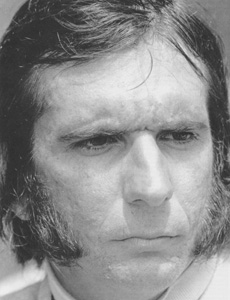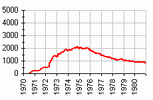Гонщики, F | |
Fittipaldi, Emerson Курсивом отмечены гонщики, |
| Эмерсон ФиттипальдиFittipaldi, Emerson |
 (c) 'Who is Who' by Steve Small, 2000 Родился: 12.12.1946 Сан-Паулу Сезонов в Ф1: Лет в Ф1: 11 Гран При: Старты: 144* *не стартовал: 12 Победы: - подряд: 2 Подиумы: - подряд: 6 Поул-позиции: - подряд: 2 Первый ряд: - подряд: 4 Быстрые круги: - подряд: 3 Лучший финиш: Лучший старт: 1 Дубли: Хет-трики: Лидирование старт/финиш: Большие шлемы: Круги: - лидирования: 478 Километры: - лидирования: |
Год | Команда | Шасси |
Crowned the youngest-ever World Champion at 25 in 1972, Emerson Fittipaldi was one of the outstanding drivers of the seventies, but a spectacularly ill-judged career move at the end of 1975 turned him into a Grand Prix racing also-ran, before he came back from retirement to forge a second magnificent career and conquer the world of Indy Car racing.
Success in Brazil led Fittipaldi to turn his sights to Europe. The sale of his Formula Vee car financed a three-month trip to England in 1969 and he quickly made his mark in a Formula Ford Merlyn. Emerson's talent was obvious and a move up to F3 in a Jim Russell Lotus 59 paid immediate dividends, the Brazilian winning a string of races, which gave him the confidence to move into Formula 2 with Mike Warner in 1970. An outright win eluded him, but he finished virtually every race in the top six, and Colin Chapman soon had his signature on a Lotus F1 contract.
Fittipaldi was eased onto the Grand Prix scene with a Lotus 49C, but tragedy soon befell the team with the death of Jochen Rindt at Monza. Emerson was suddenly thrust into the spotlight upon the team's return at Watkins Glen, and he provided a great morale booster for Chapman by winning the race, albeit only after Rodriguez hit trouble late on. For 1971 Fittipaldi was given the number one seat, but lost momentum after a mid-season road accident. Nevertheless he did remarkably well in his first full Formula 1 season and, with the Lotus 72 finely honed, he became the man to beat the following year. Victories in the Race of Champions and International Trophy provided the springboard for a mid-season burst of scintillating form which saw him claim the World Championship.
Joined in the team by Ronnie Peterson for 1975, Emerson was quick straight out of the blocks with three wins in the first six Grands Prix, and a second title looked a formality, but his year then turned sour, particularly after a practice crash at Zandvoort left him with a niggling ankle injury. By the end of the season he was somewhat overshadowed by Peterson and accepted a big-money offer from McLaren for 1974. It proved to be a wise decision, his smooth, unruffled driving and great tactical acumen bringing him his second World Championship in an evenly contested season. The following year yielded just one Grand Prix win at Silverstone, Emerson keeping his head in a rainstorm while those all around were spinning out. In the end Lauda's Ferrari had the legs of his McLaren, and he had to settle for second place in the championship.
Then came the bombshell. He was to join the Copersucar-Fittipaldi team established by his brother Wilson for 1976 to drive the outfit's well-funded but uncompetitive Brazilian-built challenger. From Olympian heights, Emerson soon found himself in a valley of despair as the project struggled on, occasionally breaking into the top six but achieving little else. A magnificent race at Rio in 1978, when he finished a brilliant second to Reutemann's Ferrari, and an excellent third place at Long Beach in 1980 were but isolated reminders of former glories. At the end of that season Emerson switched from driving to management duties but the Fittipaldi team was finally forced to close its doors at the end of 1982.
Returning home to Brazil, he concentrated on the family orange-growing and automobile accessory businesses, not missing racing in the slightest. A few races in super karts for fun in 1983 led to an invitation to take part in an IMSA race at Miami early in 1984 and he enjoyed himself so much that he was soon tempted to accept an Indy Car drive at Long Beach, finishing a remarkable fifth. The wheel-to-wheel racing ignited Emerson's lost passion for driving and he was soon to get a big break, joining the Patrick Racing team to replace the severely injured Chip Ganassi. With Fittipaldi as the focal point, the team steadily grew in stature, ultimate success arriving in 1989 when he not only won the PPG Indy Car World Series title but also took a famous last-gasp win in the Indy 500 after a coming-together with Al Unser Jnr on the penultimate lap.
'Emmo' joined Roger Penske's three-car team in 1990, and was one of the undoubted top guns in the Indy Car championship. In 1993 he won the Indy 500 for the second time with a beautifully judged performance and finished second to Nigel Mansell in the points standings. Joined by Al Unser Jnr in an all-conquering three-car Penske squad for 1994, Fittipaldi proved that he still had plenty of racing mileage left. Despite recording only one win (at Phoenix), he was runner-up to the utterly dominant Unser in the PPG Cup ranking. His major disappointment came at Indianapolis where he threw the car into the wall with the race all but won. After this season of plenty for Team Penske 1995 came as a shock to the system, with Emmo and Unser struggling with the recalcitrant PC24. The nadir was the pair's failure to qualify at Indy, but there were some high spots too and Fittipaldi took a well-judged win at Nazareth.
Although the inevitable rumours of his retirement abounded, Fittipaldi had no intention of giving up competition and he was back in 1996, running a Penske under the guidance of Carl Hogan. The Brazilian put in some spirited performances, but his season - and ultimately his career - came to an abrupt end when he crashed heavily in the Marlboro 500 at Michigan.
Suffering from a crushed vertebra in his neck, the 49-year-old spent five hours in surgery and was fortunate not to have sustained permanent injury. While recovering, Emmo still hankered after a return to action, but another accident - a light aircraft crash in his native Brazil - in 1997 left him with serious back injuries. Wisely all thoughts of racing again were abandoned, but he is still a regular on the CART scene, guiding the career of the highly promising Brazilian Helio Castro-Neves.
(c) 'Who is Who' by Steve Small, 2000
| © WildSoft, 1995-2020 |



